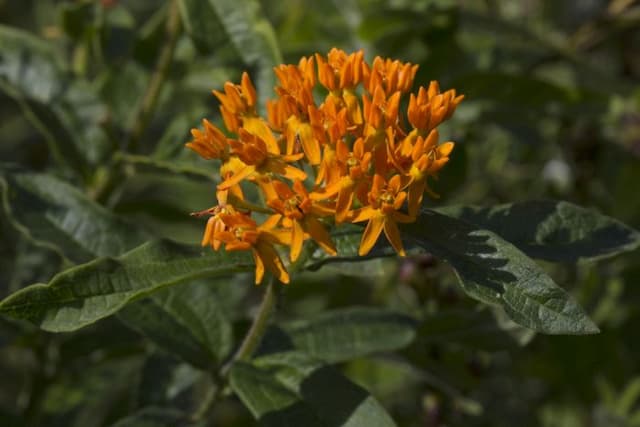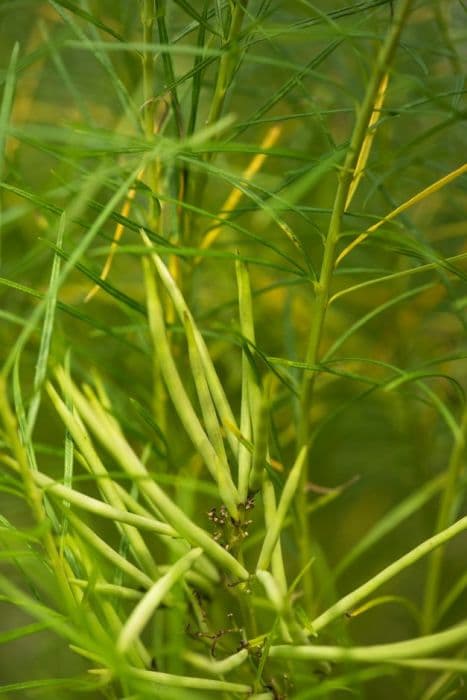Rocktrumpet Mandevilla splendens

ABOUT
Mandevilla splendens, commonly known as Mandevilla, presents a lush, tropical appearance with glossy, deep green leaves that support its enchanting display. The foliage provides a vivid backdrop to its true showpieces, the trumpet-shaped flowers. These blossoms are alluring and typically come in shades of pink, creating a contrast that's both elegant and eye-catching. The petals have a satiny sheen and radiate from the center in a harmonious, flared pattern. The heart of the bloom can sometimes be a deeper hue, adding to the dramatic effect of the flower. Additionally, the Mandevilla boasts twining stems that allow it to climb, providing a versatile use in garden designs or as a striking potted specimen. Its overall shape and the texture of both leaves and blooms contribute to the Mandevilla's reputation as a beloved decorative plant.
About this plant
 Names
NamesFamily
Apocynaceae
Synonyms
Rocktrumpet, Dipladenia, Brazilian Jasmine
Common names
Dipladenia splendens, Mandevilla splendens var. dawsonii, Mandevilla boliviensis
 Toxicity
ToxicityTo humans
Mandevilla is considered to be mildly toxic to humans if ingested. The plant contains compounds that can cause gastrointestinal upset, such as nausea, vomiting, and diarrhea. In some cases, ingestion may also lead to dermatitis or skin irritation upon contact. It is advisable to keep the plant out of reach of young children who might accidentally ingest parts of it.
To pets
Mandevilla is also toxic to pets, such as cats and dogs. Similar to its effects on humans, ingestion can lead to symptoms of gastrointestinal distress, which may include vomiting, diarrhea, and possibly drooling. Due to the plant's toxicity, pet owners should prevent their animals from chewing on or consuming any part of the plant to avoid potential health issues.
 Characteristics
CharacteristicsLife cycle
Perennials
Foliage type
Evergreen
Color of leaves
Green
Flower color
Pink
Height
10 feet (3 meters)
Spread
3 feet (1 meter)
Plant type
Climber
Hardiness zones
10
Native area
South America
Benefits
 General Benefits
General Benefits- Attracts Pollinators: Mandevilla flowers are known to attract butterflies and hummingbirds, which can help pollinate your garden.
- Aesthetic Appeal: The plant's vibrant flowers and glossy green leaves add visual interest and beauty to gardens and landscapes.
- Versatile Landscaping: Mandevilla can be used as a climbing vine on trellises, arbors, and fences, or as a groundcover, providing various landscaping uses.
- Easy Maintenance: Mandevilla plants generally require minimal care once established, making them an attractive option for gardeners of all levels.
- Drought Tolerance: They are fairly resistant to short periods of drought, reducing the need for frequent watering.
- Heat Tolerance: Mandevilla thrives in warm climates and can withstand high temperatures, making it suitable for sunny locations.
- Long Blooming Period: The flowering season for Mandevilla is long, typically lasting from late spring until the first frost, offering extended color and interest.
- Screening Properties: When used as climbers, Mandevilla can create a natural green screen, providing privacy and reducing noise.
- Container Gardening: These plants do well in pots, making them a good choice for balconies, patios, and other outdoor living spaces.
 Medical Properties
Medical PropertiesThis plant is not used for medical purposes.
 Air-purifying Qualities
Air-purifying QualitiesThis plant is not specifically known for air purifying qualities.
 Other Uses
Other Uses- Mandevilla can be trained to grow over frames or structures as living curtains, providing privacy and aesthetic appeal to balconies or patios.
- The vigorous vines of Mandevilla can be used to create a lush green roof over a pergola, reducing the heat underneath during sunny days.
- The plant can be grown in hanging baskets, with its cascading vines and flowers adding an exotic touch to the overhead space.
- Mandevilla's dense foliage can be employed as a natural screen to hide unsightly garden elements like compost bins or tool sheds.
- With creative pruning, Mandevilla plants can be shaped into unique topiary forms, making them centerpieces in garden design.
- The vibrant blossoms can be used to add a tropical flair to hand-crafted wreaths or other decorative floral arrangements.
- Mandevilla vines are sometimes used in butterfly gardens to attract pollinators with their bright, trumpet-shaped flowers.
- In educational settings, Mandevilla can be incorporated into lessons about plant training and pruning techniques for horticulture students.
- When planted in portable containers, Mandevilla can be strategically placed to guide foot traffic flowthrough a garden or public space.
- Creative gardeners might use the vines of Mandevilla to spell out letters or create living art installations in larger landscape designs.
Interesting Facts
 Feng Shui
Feng ShuiThe Mandevilla is not used in Feng Shui practice.
 Zodiac Sign Compitability
Zodiac Sign CompitabilityThe Mandevilla is not used in astrology practice.
 Plant Symbolism
Plant Symbolism- Passionate Love: The Mandevilla's vibrant, trumpet-shaped flowers are often associated with feelings of deep affection and romance.
- Charm and Beauty: Its alluring appearance symbolizes an enchanting beauty that captivates and charms those who encounter it.
- Tropical Escape: Native to South America, Mandevillas evoke images of an exotic getaway, symbolizing escape and relaxation.
- Positive Energy: The lush, vigorous growth of Mandevillas represents the vitality of life and encourages a positive atmosphere.
- Spiritual Pursuit: The upward growth and reaching vines of the plant can be symbolic of striving for higher spiritual understanding or goals.
 Water
WaterThe Dipladenia, commonly known as Mandevilla splendens, should be watered regularly during its growing season, which is from spring through summer. Its soil should be kept moist but not waterlogged, meaning you may need to water it once every week or two, depending on the climate and the plant's exposure to heat. Always allow the top inch of soil to dry out between watering sessions. When watering, use roughly 16 to 24 ounces of water for a pot with a diameter of about 10 inches, ensuring even distribution across the soil. Decrease watering in the fall and winter when the plant is dormant.
 Light
LightDipladenias thrive in bright, indirect light and should be placed in a location where they receive dappled sunlight or partial shade. Direct, harsh sunlight can damage the leaves, so a spot that gets morning light with afternoon shade or filtered sunlight through a curtain is ideal. They can also grow under bright artificial light if natural light is not sufficient.
 Temperature
TemperatureDipladenias prefer warm temperatures and should be kept in an environment where the temperature ranges from 60 to 70 degrees Fahrenheit. They can withstand temperatures as low as 50 degrees Fahrenheit at night but should not be subjected to temperatures below that as they are not frost-tolerant. The ideal temperature range to promote flowering and healthy growth is between 65 and 80 degrees Fahrenheit.
 Pruning
PruningPruning Dipladenias encourages bushier growth and more blooms. Prune the plant in late winter or early spring before new growth begins, removing any dead or damaged stems and shaping the plant as desired. Pruning can be done again after the main flowering period to maintain shape and size. Always use clean, sharp pruning shears for a clean cut.
 Cleaning
CleaningAs needed
 Soil
SoilThe Rocktrumpet thrives in a well-draining, fertile potting mix with added perlite or sand for aeration. A peat-based mix works well. The ideal soil pH is slightly acidic to neutral, ranging from 6.0 to 7.5.
 Repotting
RepottingRocktrumpets should be repotted every two to three years or when they outgrow their current pot. Spring is the best time to repot to minimize stress on the plant.
 Humidity & Misting
Humidity & MistingRocktrumpets prefer moderate to high humidity levels, around 50-70%. Avoid placing in very dry environments.
 Suitable locations
Suitable locationsIndoor
Grow Rocktrumpet near bright windows; avoid direct strong sun.
Outdoor
Plant Rocktrumpet in partial sun, shelter from harsh rays.
Hardiness zone
10-11 USDA
 Life cycle
Life cycleMandevilla splendens, commonly known as Rocktrumpet, begins its life as a seed, which germinates in warm, moist soil conditions. Upon sprouting, the seedling develops a root system and foliage leaves, prioritizing the establishment of a good root base and foliage for photosynthesis. As it matures into a vegetative state, the Rocktrumpet grows vigorously, climbing structures or supporting itself with twining stems. During the flowering stage, which often occurs in the warmer months, the plant produces large, trumpet-shaped flowers ranging from white to pink and red, attracting pollinators. After pollination, it sets fruit, which contains seeds, completing the reproductive cycle. The plant can then enter a period of dormancy in cooler climates or continue growing in tropical conditions, where it is often evergreen.
 Propogation
PropogationPropogation time
Spring-Summer
Propogation: The most popular method of propagation for Mandevilla, often known as Rocktrumpet, is through stem cuttings. This is typically done in spring or early summer when the plant is actively growing. To propagate Mandevilla by cuttings, a gardener should select a healthy, non-flowering stem and cut a 4 to 6 inch (10 to 15 centimeters) section just below a leaf node. It’s advised to remove the lower leaves and dip the cut end in a rooting hormone for better results. The cutting should then be planted in a pot with well-draining soil, watered thoroughly, and covered with plastic to maintain humidity. It's important to keep the soil moist, not soggy, and to place the pot in a warm place with indirect light. Roots will typically form within a few weeks, after which the new Mandevilla plant can gradually acclimate to less humid conditions.









